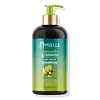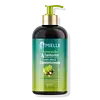What's inside
What's inside
 Key Ingredients
Key Ingredients

 Benefits
Benefits

 Concerns
Concerns

 Ingredients Side-by-side
Ingredients Side-by-side

Water
Skin ConditioningCocamidopropyl Betaine
CleansingSodium Methyl 2-Sulfolaurate
CleansingDisodium 2-Sulfolaurate
CleansingCocamide Mipa
EmulsifyingPEG-150 Distearate
EmulsifyingPolyquaternium-10
Tetrasodium Glutamate Diacetate
Persea Gratissima Oil
Skin ConditioningCalophyllum Inophyllum Seed Oil
AntimicrobialCurcuma Longa Root Extract
MaskingChlorphenesin
AntimicrobialCitric Acid
BufferingParfum
MaskingAnthocyanins
Cosmetic ColorantWater, Cocamidopropyl Betaine, Sodium Methyl 2-Sulfolaurate, Disodium 2-Sulfolaurate, Cocamide Mipa, PEG-150 Distearate, Polyquaternium-10, Tetrasodium Glutamate Diacetate, Persea Gratissima Oil, Calophyllum Inophyllum Seed Oil, Curcuma Longa Root Extract, Chlorphenesin, Citric Acid, Parfum, Anthocyanins
Water
Skin ConditioningCetearyl Alcohol
EmollientOlea Europaea Fruit Oil
MaskingCocos Nucifera Oil
MaskingPrunus Amygdalus Dulcis Oil
Skin ConditioningCetrimonium Chloride
AntimicrobialCaprylic/Capric Triglyceride
MaskingBehentrimonium Methosulfate
Sesamum Indicum Seed Oil
EmollientPersea Gratissima Oil
Skin ConditioningBehentrimonium Chloride
PreservativeAloe Barbadensis Leaf Juice
Skin ConditioningCalophyllum Inophyllum Seed Oil
AntimicrobialButyrospermum Parkii Butter
Skin ConditioningCurcuma Longa Root Extract
MaskingPanthenol
Skin ConditioningCetearyl Olivate
Sorbitan Olivate
EmulsifyingPPG-3 Benzyl Ether Myristate
EmollientIsostearyl Isostearate
EmollientQuaternium-80
Phenoxyethanol
PreservativeBenzoic Acid
MaskingEthylhexylglycerin
Skin ConditioningGlycereth-2 Cocoate
EmulsifyingParfum
MaskingAnthocyanins
Cosmetic ColorantWater, Cetearyl Alcohol, Olea Europaea Fruit Oil, Cocos Nucifera Oil, Prunus Amygdalus Dulcis Oil, Cetrimonium Chloride, Caprylic/Capric Triglyceride, Behentrimonium Methosulfate, Sesamum Indicum Seed Oil, Persea Gratissima Oil, Behentrimonium Chloride, Aloe Barbadensis Leaf Juice, Calophyllum Inophyllum Seed Oil, Butyrospermum Parkii Butter, Curcuma Longa Root Extract, Panthenol, Cetearyl Olivate, Sorbitan Olivate, PPG-3 Benzyl Ether Myristate, Isostearyl Isostearate, Quaternium-80, Phenoxyethanol, Benzoic Acid, Ethylhexylglycerin, Glycereth-2 Cocoate, Parfum, Anthocyanins
Ingredients Explained
These ingredients are found in both products.
Ingredients higher up in an ingredient list are typically present in a larger amount.
Anthocyanins are organic pigments found in plants. They play a role in a plant's reproduction process. Anthocyanins also give fruits and vegetables their color.
There are more than 300 types of Anthocyanins.
Anthocyanins have antioxidant properties. Antioxidants help fight free-radicals. Free-radicals are molecules that may damage your skin cells.
Ongoing research is being conducted on whether Anthocyanins have UV protectant properties.
Fruits that are black, blue, brighr red, and pink contain the highest amounts of Anthocyanins.
Learn more about AnthocyaninsCalophyllum Inophyllum Seed Oil comes from the Tamanu tree. This tree grows in tropical regions of Asia and Polynesian countries such as Fiji.
Calophyllum Inophyllum Seed Oil contains many fatty acids such as linoleic, oleic, stearic, and palmitic acid. These properties help your skin stay hydrated.
As an antioxidant, Calophyllum Inophyllum Seed Oil may also slow down the signs of aging. Antioxidants help fight unstable free-radical molecules. These molecules may damage your skin cells and speed up aging. By helping to stabilize these molecules, antioxidants may help slow the signs of aging.
A study from 2015 found Tamanu oil to have antibacterial and anti-inflammatory properties.
Another study from 2009 found Tamanu Oil to help absorb UV rays. However, this should not replace your sunscreen.
Due to the fatty acid content, this ingredient may not be fungal-acne safe.
Learn more about Calophyllum Inophyllum Seed OilCurcuma Longa Root Extract is from the spice, turmeric. Besides being a healthy and delicious spice, turmeric also has plenty of skincare benefits. It has anti-inflammatory, antioxidant, and anti-microbial properties.
Turmeric contains curcumin, an antioxidant. Antioxidants help neutralize unstable free-radical molecules. Free-radical molecules may damage your skin's cells and DNA. Curcumin may help with anti-aging.
Curcumin also has anti-inflammatory properties and can help soothe skin and reduce irritation. On top of that, curcumin has been shown to help prevent hyperpigmentation from sun damage.
The anti-microbial property of turmeric can make it effective in treating acne. This property has also been shown to help regulate the production of sebum.
Learn more about Curcuma Longa Root ExtractParfum is a catch-all term for an ingredient or more that is used to give a scent to products.
Also called "fragrance", this ingredient can be a blend of hundreds of chemicals or plant oils. This means every product with "fragrance" or "parfum" in the ingredients list is a different mixture.
For instance, Habanolide is a proprietary trade name for a specific aroma chemical. When used as a fragrance ingredient in cosmetics, most aroma chemicals fall under the broad labeling category of “FRAGRANCE” or “PARFUM” according to EU and US regulations.
The term 'parfum' or 'fragrance' is not regulated in many countries. In many cases, it is up to the brand to define this term.
For instance, many brands choose to label themselves as "fragrance-free" because they are not using synthetic fragrances. However, their products may still contain ingredients such as essential oils that are considered a fragrance by INCI standards.
One example is Calendula flower extract. Calendula is an essential oil that still imparts a scent or 'fragrance'.
Depending on the blend, the ingredients in the mixture can cause allergies and sensitivities on the skin. Some ingredients that are known EU allergens include linalool and citronellol.
Parfum can also be used to mask or cover an unpleasant scent.
The bottom line is: not all fragrances/parfum/ingredients are created equally. If you are worried about fragrances, we recommend taking a closer look at an ingredient. And of course, we always recommend speaking with a professional.
Learn more about ParfumPersea Gratissima Oil is also known as avocado oil.
Avocado Oil has antioxidant properties. It is mostly made up of the glycerides of fatty acids. About 67% of these fatty acids is made up of oleic acid. Palmitic acid and linoleic acid are also present.
These fatty acids help hydrate and soften the skin. It may increase collagen content in the skin. Collagen helps keep your skin plump and firm. This ingredient helps reduce inflammation and has not shown to clog pores.
This ingredient may not be fungal-acne safe due to its high fatty acid content.
Avocados also have B vitamins, vitamin K, vitamin C, vitamin E, and potassium.
Learn more about Persea Gratissima OilWater. It's the most common cosmetic ingredient of all. You'll usually see it at the top of ingredient lists, meaning that it makes up the largest part of the product.
So why is it so popular? Water most often acts as a solvent - this means that it helps dissolve other ingredients into the formulation.
You'll also recognize water as that liquid we all need to stay alive. If you see this, drink a glass of water. Stay hydrated!
Learn more about Water